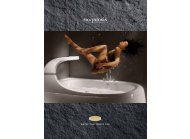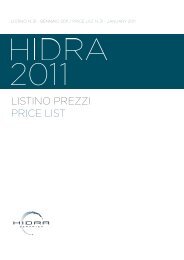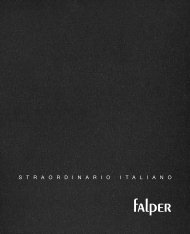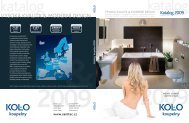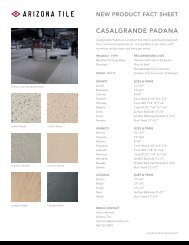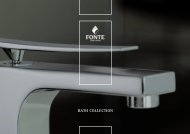DORNBRACHT - Butterfly Trading
DORNBRACHT - Butterfly Trading
DORNBRACHT - Butterfly Trading
You also want an ePaper? Increase the reach of your titles
YUMPU automatically turns print PDFs into web optimized ePapers that Google loves.
<strong>DORNBRACHT</strong> the SPIRITof WATER Ritual Architecture<br />
INVITATION TO LINGER A WHILE<br />
The world of MEM is presented in an ideal environment<br />
that no longer has anything in common<br />
with the white tiled six-and-a-half-square-metre<br />
wet room which has established itself in our latitudes<br />
as the standard bathroom. Hitherto in the<br />
ground plan architects have largely assigned this<br />
to a residual area along the only installation wall –<br />
the design of the area should be cost-effective and<br />
above all functional, as after all no visitor ever saw<br />
it. Why should any importance be attached to generous<br />
proportions, demanding materials or adequate<br />
lighting in the bathroom, which, unlike the<br />
living room or kitchen, is not intended to be<br />
shown to guests. Because the bathroom is the only<br />
area where you can rest undisturbed and where the<br />
priority is your own physical and mental wellbeing.<br />
Mike Meiré gave people and their ritual of<br />
cleansing centre stage in his considerations on<br />
MEM, a creation by Sieger Design – and ahead of<br />
the concrete product development created a totally<br />
new bathroom architecture. The designer and<br />
art director is responsible, together with his<br />
agency Meiré und Meiré, inter alia for the<br />
Dornbracht communication. Kristina Raderschad<br />
talking to Mike Meiré.<br />
K.R.: What was the starting point for you in your<br />
considerations of the MEM fittings series developed<br />
by Sieger Design?<br />
M.M.: Several years ago as part of the “Energetic<br />
Recovery System” I designed a sort of pipeline, as<br />
an outline of an idea of the bathroom of the future.<br />
I realised that there were other levels of cleansing<br />
that the bathroom should provide: a mental cleansing<br />
in addition to the purely physical. A level transcending<br />
wellness in the normal sense, over and<br />
above body treatments, applied from the outside:<br />
it is much more a matter of a healing process,<br />
restoring balance, replenishing one with new<br />
power and energy. Only when the bathroom fulfils<br />
these ideal functions does it become a cultural<br />
place.<br />
K.R.: What is necessary to create the kind of bathroom<br />
that allows the regeneration of body and<br />
mind?<br />
M.M.: The bathroom is the only place in the house<br />
that gives you the opportunity to withdraw inside<br />
yourself, find peace, come to terms with yourself.<br />
And so the aspect of dematerialising was important<br />
to me, a spiritual void in place of a cluttered<br />
space. Space itself is defined as the most precious<br />
commodity that remains untouched as far as possible,<br />
but is charged with atmosphere. I designed a<br />
room with generous proportions in which the<br />
products withdraw from view. Here, neither the<br />
ground plan design nor the illustrated furnishing<br />
elements are to be taken dogmatically. They function,<br />
quite the contrary, as the placeholders of an<br />
idea. Any form of design must be restrained in<br />
020<br />
MEM Ritual Architecture<br />
order to create peace. I can only find myself, turn<br />
myself inside out, as it were, in a room that is as<br />
neutral as possible, that does not make any formal<br />
aesthetic statement to divert or burden me.<br />
K.R.: So the bathroom becomes a kind of monastery<br />
cell?<br />
M.M.: The basic idea is very similar, but without<br />
the aspect of self-mortification and total isolation<br />
from the outside world. In my design I do not<br />
exclude the complexity of the world, quite the<br />
opposite, I integrate its poetic quality into the interior<br />
design – and create a vista from the bathroom<br />
into a kind of Garden of Paradise symbolising the<br />
diversity of the world. What is produced, therefore,<br />
is a form of minimalism but which simultaneously<br />
allows a form of poetry from everyday<br />
life: a room that is empty and yet sensual. The<br />
bathroom becomes a kind of capsule where you<br />
can stop and stay – and spend more than just ten<br />
minutes.<br />
K.R.: What – apart from the Garden of Paradise<br />
already mentioned – are the essential elements of<br />
your room concept?<br />
M.M.: The architecture should as far as possible<br />
be plain, hence the decision for a rectangular floor<br />
plan. Without being diverted to the right or left,<br />
you can walk through the room, which is arranged<br />
on the basis of a fixed sequence of daily cleansing<br />
rituals. If you go through these rituals more conscientiously<br />
it becomes a form of meditation and<br />
they therefore are the key to your well-being.<br />
Along the wall a linear washstand with a generously<br />
proportioned shelf leads into the room. This<br />
is where the ritual of grooming and beauty-care<br />
takes place. On the front wall of the room a bath<br />
tub is set in the floor. Bathing becomes a ritual:<br />
instead of stepping up into the tub, you let yourself<br />
– as in old mansions – glide down into the<br />
base. Warm water comes bubbling out of the wall<br />
like out of a spring feeding into the tub. A gentle<br />
shower rains down from above, from a shower that<br />
is no longer recognisable as such. Reduced to a<br />
rectangular plate integrated into the ceiling, the<br />
product is only defined as an interface in the<br />
architecture. From the tub, the view leads into an<br />
atrium with the aforementioned Garden of<br />
Paradise. After bathing you sit on the wooden<br />
bench next to the basin. The awaiting cushion and<br />
the incense stick invite you to a ritual of relaxation:<br />
You light one of the incense sticks, direct<br />
your attention to the few important architectural<br />
details, take the time to observe, reflect and relax.<br />
Here what matters is not the actual cushion or<br />
incense stick, but the question: can you create a<br />
room which allows ideal functions, such as pausing<br />
and reflecting – can you create a room which<br />
invites raising consciousness?<br />
K.R.: In this context what role does the light play<br />
that shines down through what appears to be randomly<br />
arranged circular holes in the ceiling?<br />
M.M.: The circular “light holes” in the ceiling<br />
point in the same direction: if you sit down on the<br />
daybed – which also seems to float, to accentuate<br />
the lightness you feel after bathing, the relief from<br />
everyday life, a kind of floating feeling – they<br />
express an invitation to reflect and meditate. Anyone<br />
who has ever lain on the hot marble table in<br />
the middle of an oriental hammam, looking at the<br />
ceiling that is perforated with innumerable, sometimes<br />
coloured, glass light apertures is familiar<br />
with the unbelievably calming, almost hypnotic<br />
effect. In general light is of crucial importance in<br />
a room where we want to feel good even when<br />
naked, which we enter first thing in the morning<br />
and last thing at night. Different lighting scenarios<br />
respond to the various moods in the morning and<br />
evening – sometimes light is stimulating, sometimes<br />
relaxing.<br />
INVITO ALL’INDUGIO<br />
Il mondo di MEM è presentato in un ambiente<br />
ideale, completamente diverso dal locale da<br />
6,5 m 2 piastrellato di bianco, tipico dello<br />
standard occidentale. Finora gli architetti nei<br />
progetti generalmente gli dedicavano uno spazio<br />
ricavato lungo l’unica parete sfruttabile e lo allestivano<br />
all’insegna dell’economicità e soprattutto<br />
della funzionalità, perché tanto nessun ospite lo<br />
vedeva. Perché in bagno bisognerebbe porre l’accento<br />
sulla grandezza, su materiali pregiati o su<br />
una buona illuminazione, se esso, contrariamente<br />
al soggiorno o alla cucina, non svolge alcuna funzione<br />
rappresentativa? Perché il bagno è l’unica<br />
stanza dove ci si può occupare di se stessi, indisturbati<br />
e in tutta tranquillità, dove ci si può con-<br />
<strong>DORNBRACHT</strong> the SPIRITof WATER Ritual Architecture<br />
Wash-stand with petite coiffeuse Meditation place Wash-stand in front of Garden of Eden<br />
centrare sul proprio benessere fisico e spirituale.<br />
Mike Meiré ha posto l’uomo e i rituali del bagno<br />
al centro delle sue riflessioni sul mondo MEM,<br />
creato da Sieger Design, e, prima di dedicarsi allo<br />
sviluppo concreto dei prodotti, ha ideato un’architettura<br />
assolutamente innovativa per questo spazio.<br />
Il designer e direttore artistico è responsabile<br />
tra l’altro, con la sua agenzia Meiré und Meiré,<br />
della comunicazione di Dornbracht. Intervista di<br />
Kristina Raderschad a Mike Meiré.<br />
K.R.: Qual è stato per lei il punto di partenza per<br />
le riflessioni sulla serie di rubinetterie MEM,<br />
create da Sieger Design?<br />
M.M.: Qualche anno fa, nell’ambito dell’“Energetic<br />
Recovery System”, ho sviluppato una<br />
specie di canalizzazione che doveva schematizzare<br />
l’idea del bagno del futuro. Mi sono reso conto<br />
allora che esiste un’altra concezione di questo<br />
MEM RITUAL ARCHITECTURE<br />
A bath tub sunk into the<br />
sandstone floor with a small<br />
seating area “on the bank”,<br />
nature integrated into the<br />
bathroom as a Garden of Eden<br />
for mind and soul, coloured<br />
light as an expression of<br />
natural moods and a couch<br />
which seems to float – and<br />
with its airiness invites you<br />
to dream.<br />
Vasca annegata nel pavimento<br />
in grès con una piccola<br />
seduta sul bordo, natura<br />
integrata nel bagno come<br />
giardino dell’Eden per l’anima<br />
e lo spirito, luce colorata che<br />
accompagna atmosfere<br />
naturali e una poltrona che<br />
sembra galleggiare, la cui<br />
leggerezza invita al sogno.<br />
Una bañera encajada en el<br />
suelo de gres con una pequeña<br />
área de asiento “a la orilla”,<br />
naturaleza integrada en<br />
el baño en forma de Jardín<br />
del Edén para el espíritu y el<br />
alma, luz de colores como si<br />
se estuviera aludiendo a los<br />
estados de humor naturales<br />
y una tumbona que parece<br />
flotar – y que con su ligereza<br />
invita a soñar.<br />
021





![Katalog USAKANG retro vany [ pdf, 0.6 MB ] - Butterfly Trading](https://img.yumpu.com/47275139/1/190x134/katalog-usakang-retro-vany-pdf-06-mb-butterfly-trading.jpg?quality=85)
